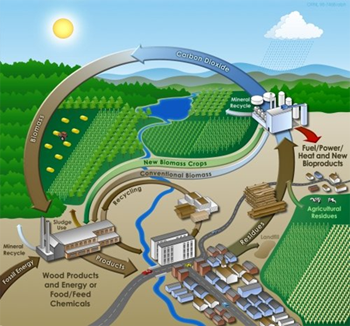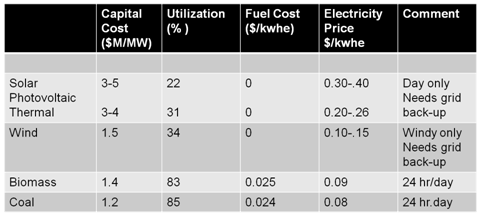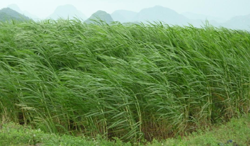Biomass Solutions
Biomass is a low-carbon fuel or energy source that comes from plant material such as wood, corn, sugar cane and grasses such as Giant King Grass. Biomass can be burned to generate electricity and heat, digested to produce bio methane, and converted into liquid biofuels, biochemicals and bio plastics.
Biomass also includes byproducts such as agricultural waste-for example, corn straw (stover) and rice husks-and food waste such as vegetable oil recycled from cooking processes. Since biomass comes primarily from plants and vegetation that naturally re-grows and may come from everyday agricultural or industrial processes, biomass is a renewable resource.
Biomass vs. Fossil Fuels: Renewable, Low Carbon, Locally Sourced, Low Cost
In addition to being renewable, biomass' carbon emissions and local access relative to fossil fuels are important considerations. While coal may be 20% less costly than biomass right now, coal is also responsible for producing the most carbon emissions and other pollutants than any other fuel source. Other fossil fuels are significantly more costly and also produce high levels of pollution.

Carbon-Neutral Cycle
Since planting, harvesting and transportation equipment use petroleum-based fuel, and many fertilizers are also petroleum based, some carbon emissions occur with biomass. However, when grass crops are grown using sustainable methods, the amounts of carbon emissions are small, especially compared to the energy that will be produced by burning the biomass, and the net result is very low carbon emissions, compared to burning coal or other fossil fuels.
Biomass is available in many areas throughout the world and can be cultivated or produced domestically-locally or regionally-with little or no supply or logistical risk. In contrast, reserves of oil and natural gas are located in limited areas throughout the world and are a depleting resource. Furthermore, the majority of known and accessible reserves are located in foreign countries, and supplies are controlled by foreign entities. In addition, finding and developing new reserves are relatively costly and risky. This general lack of access, compared to rising demand for energy, is causing the usual political, economic and widening range of environmental problems to worsen each year.
Biomass vs. Other Alternative Energy: High Reliability, Low Cost
While it is generally accepted that all sources of alternative, cleaner, green energy, including biomass, should be developed to reduce dependence on fossil fuels. There are practical and significant differences between the major alternative categories of alternative energy.

Biomass vs. other Alternative Energy
For example, solar and wind offer the important advantage of zero fuel cost, but they have higher capital costs and much lower utilization rates because solar only produces electricity when it is sunny and wind when it is windy. The combination of high capital costs and low utilization lead to high electricity prices. Because of their transient nature and variability of weather conditions, solar and wind energy cannot be used as base power and are largely utilized in sophisticated grids where there are back up natural gas power plants that can take up to load on cloudy or windless days. Biomass and coal power plants operate 24 hours a day and are used as base power.
Even though the biomass fuel costs money and is not free like the wind and sun, lower capital costs and a much higher utilization rate more than compensate, and the price of biomass electricity is substantially cheaper than solar and even wind. Note that electricity generated from coal is still the cheapest, but only by 10 to 15% compared to biomass.
Biomass electricity is cost-effective and practical, and it offers a realistic and sustainable alternative to fossil fuels. Biomass is versatile and can also be used to produce bio-methane to replace natural gas, liquid biofuels to replace gasoline and diesel fuel, and as feedstock to produce biochemicals and bio plastics.
Biomass Alternatives: Dedicated Energy Crops vs. Waste
The primary requirements that a biomass crop must satisfy to be considered a viable source of green energy are:
- No conflict with food-crop acreage or food-supply chain
- Scalability to meet demand for large amounts of electrical energy, bio-fuels, bio-gas, and other green-energy products
- Continuity of supply with consistent quality
- Low and predictable cost for the 20+ year life of a biomass power plant or biofuel refinery
However agricultural waste has several problems:
- It is seasonal and is not available until the food crop or cotton crop is harvested. At harvest, there is an abundance of waste, but this must be gathered, dried and stored until the next crop is harvested.
- In different seasons, wastes from different crops become available and there is no consistency of the fuel or feedstock.
- Reliability of supply is uncertain. A farmer may decide from year-to-year what to grow and the waste from the new crop may not be suitable for the biomass application.
- It is expensive. Although the waste originally had little value to the farmer and was often burned or plowed under, farmers in India, China and Thailand have tripled the price over the last several years.
- The agricultural waste market is a spot market with short-term pricing, and very few long-term contracts have ever been signed. It is difficult to get biomass project financing without an assured source of fuel or feedstock at a known price.
- Agricultural waste must be collected over a substantial radius-- say 50 km-- and this presents logistic problems.
Because of these issues, many biomass power plants in India for example are running at partial capacity because biomass is not available or closed down because the fuel is too expensive to operate profitably.

Giant King Grass Plantation (13 Feet Tall)
Among the different types of dedicated energy crops, non-food perennial grasses are practical and effective for producing green energy. Giant King Grass can be grown in areas considered marginal or unsuitable for food crops. Therefore, cultivation of non-food grasses does not compete with food or food-related crops such as corn; nor does it interfere or compete with valuable natural resources such as forests and other timberland. The use of food crops for bio-fuels is being discouraged or banned in almost all countries worldwide.
